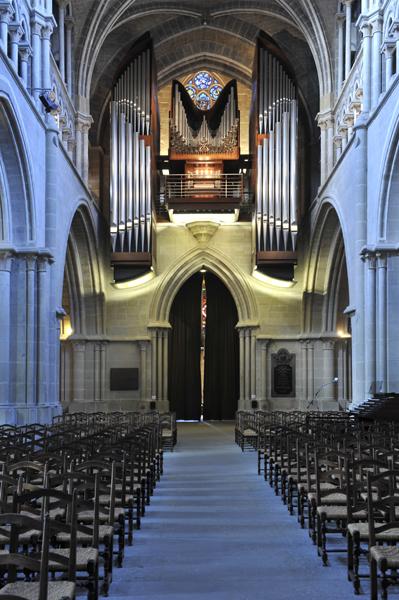Lausanne organ pulls out all the stops

The 7,000-pipe organ in Lausanne Cathedral is one of the most expensive instruments in the world, but experiencing its sheer power and unique harmonics is priceless.
It is the first organ to feature four styles, the first to have been designed by a designer, and the first in a European cathedral to have been constructed by a company from the United States.
“We had to wait until the beginning of the 21st century for a really wonderful organ,” Jean-Christophe Geiser, organist at Lausanne Cathedral since 1991, told swissinfo.
When the electro-pneumatic transmission system of the 1955 instrument developed breathing difficulties, Vaud cantonal government agreed in 1996 to a new organ. Two competitions were organised: one for the builder, one for the designer.
In 1998 the winners were announced: Massachusetts-based C.B. Fisk would build the organ, and Italian designer Giugiaro would take care of the case.
Lausanne’s new king of instruments was inaugurated in 2003 – after ten years and more than SFr5 million ($4.2 million) – to mark the 200th anniversary of Vaud joining the Swiss Confederation.
The previous organ ended up being transplanted to the Philharmonic Hall in Gdansk, Poland.
Pipe dream
All organs are unique, but some are more unique than others.
“There’s only one instrument in Switzerland with more pipes – but the size isn’t really the point,” said Geiser, a driving force behind the new instrument.
The largest organ in Switzerland is in the Klosterkirche in Engelberg, which has four manuals and 9,097 pipes.
By contrast, the largest organ ever built, at the Atlantic City Convention Hall in the United States, has seven manuals and more than 32,000 pipes.
The oldest playable organ in the world is thought to be in the church of Notre-Dame-de-Valère in Sion. Its oldest parts date back to 1435, but they include only most of the case and no more than 12 original pipes.
“The concept was to have four styles: Classical French, Symphonic French, Romantic French and North German baroque. To put all four styles in the same instrument is unique.”
Organs are essentially just a collection of whistles, but their tone and pitch varies dramatically depending on their size, shape and material.
Like an artist mixing a palette, an organist has to select the stops (sets of pipes) that, in their opinion, best suit the music – also taking into account the surrounding acoustics. The Fisk organ has 100 stops.
“The main thing is that this instrument is incredibly versatile,” said Geiser. “For example on the Mooser organ in Fribourg Cathedral you are limited to certain music, and the same goes for the Silbermann organ in Arlesheim on which you can’t really play French Romantic music.”
Global effort
For decades all new organs of the main Swiss cathedrals have been built by Swiss manufacturers.
“We wanted to create an instrument with these four styles, but if we had chosen a French or German organ builder it would have been too French or too German – and we would have had the same problem with a Swiss organ builder,” explained Geiser, adding that Fisk have an excellent knowledge of European organ styles.
Another first is employing a designer to design the organ case. Giugiaro, who shaped the Lamborghini and many other cars, modelled the organ’s “body” on an angel floating on a cloud of light.
Building an organ is fiddly – you won’t find one of these in Ikea – and the Fisk organ took 150,000 hours of highly skilled labour. Geiser said the communication during the construction, which involved six countries, meant such an instrument could not have been conceived before the internet – “even 15 years ago”.
New audience
One of the design specifics was that the cathedral should play the role of “concert hall with organ”, since Lausanne – Switzerland’s fourth-largest city – does not have a space that caters for a repertoire for organ and orchestra, unlike other large Swiss cities.
To this end, the Fisk organ uniquely has two five-manual consoles: the first with a mechanical transmission in the gallery, the second on a platform with an electronic transmission that can be wheeled around the nave.
This mobile console lets the audience see the organist close-up – rather than just the back of their head bobbing away up in the gallery – and appreciate quite how hard co-ordinating your hands and feet really is.
Compared with playing a six-part Bach fugue, sitting back and enjoying one of the most exciting instruments in the world is embarrassingly easy.
The Fisk organ at Lausanne Cathedral, inaugurated in 2003, has 100 stops and 6,737 pipes. These range from a few centimetres to 32ft (almost ten metres) and 400kg.
It took ten years, two international meetings, a parliamentary proceeding, more than SFr5 million (the canton of Vaud paid for half, sponsorship covered the rest) and 150,000 hours of work to build the Fisk organ.
Switzerland’s biggest Gothic cathedral stands 150m above Lake Geneva.
Construction began in 1175 and in 1275 the cathedral was consecrated by Pope Gregory X. The architect Eugène Viollet-le-Duc began a restoration in the 19th century.
The interior is relatively austere except for some 13th-century choir stalls. The rose window also dates from the 13th century.
Visitors can climb the 225 steps to the observation deck of one of the two towers.
Nearly a half million people come to the cathedral every year, making it one of Switzerland’s most visited monuments.

In compliance with the JTI standards
More: SWI swissinfo.ch certified by the Journalism Trust Initiative










Join the conversation!